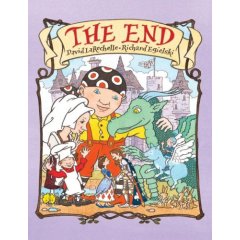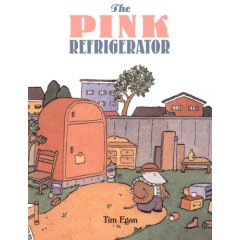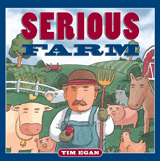Picture Book Round-Up, Part Four,
Beginning With The End
 May 17th, 2007 by jules
May 17th, 2007 by jules

by David LaRochelle and
illustrated by Richard Egielski
Arthur A. Levine Books
January 2007
(library copy)
 Teaching sequencing skills, anyone? You will want to experience this title, in which LaRochelle takes the traditional fairy tale structure and turns it on its head, saying “shh, shh, don’t speak” to conventional storytelling. And it’s delightful. I’m even going to tack a star onto this little review (though I’m not planning on making this a habit), just ’cause I like this book so much and just for fun and just so the star might catch your eye . . . When you read this one, you learn that “once upon a time a clever princess decided to make a big bowl of lemonade,” but that, in fact, is the final spread in the book (well, right before the closing title page spread). Yup, LaRochelle is giving us a backwards narrative. Instead, the book opens with — you guessed it — “{a}nd they all lived happily ever after.” Each succeeding spread is preceded by a “because”: “They lived happily ever after because . . . the soggy knight fell in love with the clever Princess. The knight fell in love with the Princess because . . . she poured a big bowl of lemonade on top of his head. She poured a big bowl of lemonade on top of his head because . . . ” You get the picture. The entire thing’s a wonderfully zany, rather screwball story involving, it turns out, a sobbing, great green dragon; one hundred frantic bunny rabbits; an enormous tomato; a flying teacup; and a giant throwing a tantrum. In the end (or, uh, beginning), we come full circle to the Princess with her big bunch of lemons, having received a most entertaining snapshot of cause-and-effect along the way. With all the (well-deserved) buzz over the stunning Hugo Cabret, you can pair this one with it in terms of those stories who depend on page turns themselves for story-forming and sense-making. The detailed illustrations are engrossing; look at this title just once and you’ll cheat yourself (you won’t want to miss the flying pig anyway). Egielski integrates hand-lettered text on banners that look like scrolls, draped on the tops and bottoms of the rustic illustration borders in the form of tree branches. His flat, rather one-dimensionally-painted characters and bright, comics-esque shades bring to mind circa-1970 Sendak (think In The Night Kitchen). As a Booklist reviewer suggests, “{p}resent this as inspiration for young storytellers, who may discover that writing a tale in reverse frees their ideas to move in unexpected directions.”
Teaching sequencing skills, anyone? You will want to experience this title, in which LaRochelle takes the traditional fairy tale structure and turns it on its head, saying “shh, shh, don’t speak” to conventional storytelling. And it’s delightful. I’m even going to tack a star onto this little review (though I’m not planning on making this a habit), just ’cause I like this book so much and just for fun and just so the star might catch your eye . . . When you read this one, you learn that “once upon a time a clever princess decided to make a big bowl of lemonade,” but that, in fact, is the final spread in the book (well, right before the closing title page spread). Yup, LaRochelle is giving us a backwards narrative. Instead, the book opens with — you guessed it — “{a}nd they all lived happily ever after.” Each succeeding spread is preceded by a “because”: “They lived happily ever after because . . . the soggy knight fell in love with the clever Princess. The knight fell in love with the Princess because . . . she poured a big bowl of lemonade on top of his head. She poured a big bowl of lemonade on top of his head because . . . ” You get the picture. The entire thing’s a wonderfully zany, rather screwball story involving, it turns out, a sobbing, great green dragon; one hundred frantic bunny rabbits; an enormous tomato; a flying teacup; and a giant throwing a tantrum. In the end (or, uh, beginning), we come full circle to the Princess with her big bunch of lemons, having received a most entertaining snapshot of cause-and-effect along the way. With all the (well-deserved) buzz over the stunning Hugo Cabret, you can pair this one with it in terms of those stories who depend on page turns themselves for story-forming and sense-making. The detailed illustrations are engrossing; look at this title just once and you’ll cheat yourself (you won’t want to miss the flying pig anyway). Egielski integrates hand-lettered text on banners that look like scrolls, draped on the tops and bottoms of the rustic illustration borders in the form of tree branches. His flat, rather one-dimensionally-painted characters and bright, comics-esque shades bring to mind circa-1970 Sendak (think In The Night Kitchen). As a Booklist reviewer suggests, “{p}resent this as inspiration for young storytellers, who may discover that writing a tale in reverse frees their ideas to move in unexpected directions.”

by Kevin Henkes
Greenwillow Books
February 2007
(library copy)
In trying to find the words to express to you how sublime Henkes’ latest book is, I feel a bit like Bruce Handy*, who reviewed the book for The New York Times last Sunday (thanks to Big A little a’s Weekend Review for the link). He spent a large part of his review talking about Henkes’ general artistic genius and previous books and then admits towards the end of his write-up:
I’ve put off mentioning {A Good Day} until now because, frankly, I don’t have all that much to say about it beyond that it is a masterpiece, an almost perfect picture book. It was written for the Kitten’s First Full Moon crowd and graced with similarly bold, though this time colorful, illustrations. Like a great Japanese meal, it is a marvel of deceptive simplicity.
(Incidentally, my favorite part of the review is when he writes, “Henkes’s best books are good for you the way art is good for you, as opposed to the way right-thinking lesson plans are”).
So, yes, word to what he says above about feeling a bit speechless here. It’s simply glorious, and I merely want to say: What else do you expect from Henkes, who gets better with each book?
This gentle story opens with, as Handy puts it, a curve ball: “It was a bad day. . .” Little yellow bird, little white dog, little orange fox, and little brown squirrel are each having — in their own, individual ways — a rough morning. “But then . . .” things turn around for them all, and a little girl makes an appearance at the book’s closing, bringing home the idea that a bad day can be turned around into a good one, that hardships can be overcome and lemons can lead to lemonade — though none of it is sugar-coated. This is Henkes we’re talkin’ about here, who knows how to keep the schmaltz at bay. Though the characters seemingly have nothing to do with one another, there’s a small twist at the end involving the little yellow bird and the girl, and Henkes brings them all back into the frame of that final illustration, making it all full-circle in more ways than one. The heavy black ink line he put to use in Kitten’s First Full Moon is back, but this time he’s added some shimmering pastels to his watercolor illustrations.
Handy writes, “{Henkes} . . . isn’t quite the household name that Dr. Seuss and Maurice Sendak are, though he should be.” Huh. I thought he was a household name. If not, he deserves to be.
To see a slideshow of Henkes’ draft illustrations (courtesy of Greenwillow Books/HarperCollins) for this flawless, little book, go see Handy’s review, and click on the multimedia link on the left.

by Tim Egan
Houghton Mifflin
April 2007
(library copy)
Tim Egan’s books are always getting described as “offbeat,” no? Well, if the shoe fits . . . Serious Farm (Houghton Mifflin, 2003) was so seriously funny to me. The understated, dry humor (“Nothin’ funny about corn”), in particular, made me pledge my undying love and respect to Egan. (There’s the cover image below in all its brilliance; I’m tacking it on here just for fun). So, it was with eagerness that I sought after The Pink Refrigerator, his newest title. It doesn’t disappoint, but it’s one of those books that  I think is more oriented toward adults than for children, though that doesn’t mean your older picture book reader won’t appreciate the message (and it’s not as much that way as last year’s So Few of Me by Peter H. Reynolds; yeesh, just shelve that one with the adult inspirational books and let’s move on). And it’s also not heavily moralizing or pedantic (Egan never goes down that road), which would have really ruined it.
I think is more oriented toward adults than for children, though that doesn’t mean your older picture book reader won’t appreciate the message (and it’s not as much that way as last year’s So Few of Me by Peter H. Reynolds; yeesh, just shelve that one with the adult inspirational books and let’s move on). And it’s also not heavily moralizing or pedantic (Egan never goes down that road), which would have really ruined it.
Dodsworth, our anthropomorphized rodent protagonist, loved to do nothing. In fact, “his motto was basically ‘Try to do as little as possible.'” He lives alone, owns a thrift shop that gets little business, watches a lot of TV, naps quite a bit, and frequents a junkyard in order to bring home oft-neglected items. Seeing an old, rusty, pink refrigerator one day, he’s baffled to find that he can’t remove the Earth-shaped magnet on its front, and on closer inspection he sees that it’s holding a note that reads, “MAKE PICTURES.” And when he opens the refrigerator, he finds paints, brushes, and a little red sketchbook. He eventually — albeit reluctantly at first — paints a picture of the ocean, which he’s never seen, and is quite surprised, since he hasn’t painted in years. The next morning, he finds another note, “READ MORE,” followed by “PLAY MUSIC,” “LEARN TO COOK,” and finally “KEEP EXPLORING” (with all the requisite supplies for each activity inside the seemingly magical appliance). At the book’s close, he’s so inspired (in the middle of his favorite TV show, he looks at the magnet and “suddenly felt a great sense of wonder about everything”) that we see him pedalling off down the road on his journey to find an ocean and live life a little bit already . . .
Am I the only one who gets a go-buy-this-for-your-favorite-new-grad vibe off this title? But if it replaced Seuss’ Oh, the Places You’ll Go! as the required purchase for graduates, I’d not complain.
Egan’s illustrations here are reminiscent of James Marshall’s with his round, squat characters, muted watercolors, thinly-bordered illustrations on white space, and more. Yet, it’s still All Egan. Dodsworth is endearing with his brown bowler, jacket, and scarf, and his world is full of details to pore over and enjoy. This one would make — particularly due to its mellow, unhurried pace — a good one-on-one, lap-sitting story with your favorite older elementary student.
* Not to be confused with Jack Handey, sage philosopher:
“When you die, if you get a choice between going to regular heaven or pie heaven, choose pie heaven. It might be a trick, but if it’s not, mmmmmmm, boy.”

Thank you for reminding me to request A GOOD DAY from the library! I adore KITTEN and I think OLIVE’S OCEAN was robbed.
Jack and Xander should be friends.
Dawn: I’m guessing on how you say it. It’s got an apostrophe. I think it’s Mmm’Fashnik, like “Mmm, cookies.”
Xander: Or maybe, Muh-Fashnik. Like Muh . . . Fashnik.